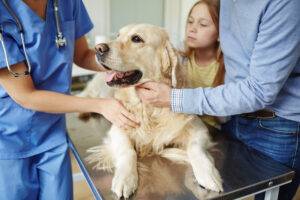Being financially prepared to look after your four-legged friend when they get sick or injured is part of being a responsible pet parent. There are a few ways to do this – you might have sufficient savings for pet health emergencies, or access to a credit card or a personal loan. Alternatively, if you have pet insurance it’s important to understand what factors impact your pet insurance policy premium, and why premiums typically rise each year.
Like all general insurance products, pet insurance is risk-rated which means there are several factors that impact the risk profile, and therefore the pricing of your policy. From your location to your product coverage to your claims history, there are many variables that influence pricing but the key factors we focus on in this article include your pets’ age and breed and technological advancements in veterinary medicine.
We review these factors in detail to explain why pet insurance premiums typically rise each year.
Got an eight-year-old French bulldog? Your pets’ breed and age affect pricing.
Pets age at a more rapid rate than humans – as one human year is equivalent to around 5.3 dog years. The accelerated rate at which pets age increases the likelihood that they’ll need veterinary care. There is a significant change in risk profile over a 12-month period. While pets experience accidents and illness at every age, older pets are more likely to experience more health conditions like arthritis and cancer, which comes at an additional cost.
In addition to a pet’s age, the breed of your dog or cat also impacts the premium pricing. Different breeds may be predisposed to certain disease states more compared to others. For example, brachycephalic (or “brachy”) breeds like French Bulldogs, Pugs or Boxers often experience Brachycephalic Obstructive Airway Syndrome (BOAS) which affects the nose, nasal passages and stenotic nares and requires significant medical treatment. Breed-specific conditions can be experienced even from a young age – for example, PetSure claims data from the past three years shows BOAS is the most claimed condition for French Bulldogs aged 0-2 years.
Technological advancements in veterinary care
Technological advancements including more effective diagnostic testing and equipment can improve the level of care provided to animals, which can drive up costs. Diagnostic testing plays a crucial role in identifying and treating animal diseases effectively, and PetSure has observed an increase in both frequency and cost of diagnostic testing, such as blood tests. The 14% YoY** increase in the uptake of blood tests in pets may play a role in early detection of health issues and effective treatment, but does come at a cost,
Costs in diagnostic testing have also increased, likely reflecting cost increases from pathology laboratories and subsequent flow-on effect to veterinary practices and clients. PetSure has observed an increase in diagnostic testing costs per claim of approximately 23% YoY**. Price increases of important substances utilised by laboratories such as bovine foetal blood for instance may play a role in increasing laboratory and pathology expenses.
Beyond just diagnostics, pet healthcare costs across the board are subject to greater inflationary pressures – while technological innovations, more sophisticated diagnostic testing and better drugs like pain relief medication have a positive impact on pet healthcare outcomes, these all come at an additional cost to the pet parent.
Pet vs human healthcare costs:
There’s a common misconception that veterinary costs exceed human medical expenses. However, PetSure research reveals the cost of procedures for some health conditions for humans is similar to the cost for pets. The difference is generally that in human healthcare, we don’t experience the full cost of healthcare thanks to a number of government initiatives including Medicare, the pharmaceutical benefits scheme (PBS) and bulk-billing.
For instance, the cost of managing a cruciate ligament repair in humans is typically $3,800 for specialist fees (including the Medicare rebate and the out-of-pocket cost) while the average cost to treat this condition in dogs ranges from $3,000 – $4,000 (which needs to be funded in full by the customer)^ according to the PetSure Pet Health Monitor 2023 Report.
Financial preparedness can lead to better animal welfare outcomes, with a recent PetSure survey showing that 40% of pet parents would consider economic euthanasia if the cost of treatment is over $3,000#. However, we know the cost to treat common health ailments like skin allergies in dogs can be as high as $17,460~ and treating traumatic injuries can cost upwards of $20,000. That’s why having a plan to help manage unplanned costs is crucial – whether that’s a dedicated savings account, a credit card, loan or a pet insurance policy.
While pet insurance premiums do generally rise every year, it’s a reasonable price to pay to know you are prepared for healthcare costs and to take care of your fur baby when they need it most.
Frequently asked questions (FAQ):
For new policies
Your premium is based on several factors. While some factors are pre-set, others can vary and can affect the premium amount depending on whether it increases or decreases the risk profile. For instance, commercial factors or product details such as the type of cover you have and the options you have selected.
Other risk factors considered include your pet’s age and breed – as your pet ages, the risk of your pet requiring treatment will rise and so the premium increases.
For renewals and changes to your policy
For renewals, we also factor in the claim history for your pet and the average cost of care for pets like yours, as well as the claims experience across all our insured pets. As these factors change your pet’s risk profile, your premium will increase from year to year.
When calculating your premium on renewal, we also consider how much your premium was previously, including any discounts that may have been applied. This means that we may limit movements up or down.
These same factors and others are also used to calculate your premium if you amend your coverage.
No. Pet insurance is different to human health insurance. Human health insurance is ‘community rated’, which means everyone pays the same premium regardless of their individual health status, age or claims history. This is not the case for pet insurance, which is ‘risk rated.’
Health insurance providers can community rate health insurance because there are many other factors at play in the human health care system, such as Medicare and government rebates and subsidies, which are not present in the pet health insurance industry.
Pet insurance claim reimbursements are paid for purely by the premiums received by those who insure their pets. In order for each person to pay a fair price for their pet insurance, premiums vary depending on your and your pet’s risk factors.
Yes, your premium will generally increase each year. This is for two main reasons:
Reason #1: More health issues
Just like humans, the older our pets get, the more likely they are to have health hiccups. Cats and dogs age faster than we do, which means that their veterinary treatment costs typically go up rapidly each year too. As a result, the cost of insuring your pet will also increase as they get older.
Reason #2: Advancements in veterinary treatments
The overall cost of medical treatment for pets has increased in recent years due to the increased availability of medical treatments and technology-enabled services and ongoing demand for these services. The treatment options and advancements in technology are providing us with great opportunities to give our pets a great quality of life for longer.
While this is great news for the care of our pets, these treatments come at a significant cost. Year on year treatment costs increase, and this is factored into the cost of pet insurance.
No. PetSure research shows pet insurance premiums increase at around 20% per year, while human health insurance premiums rise by 3.5% per year. While they are two different products, if you stack the premium rise against the expected lifespan of a human or a pet, it works out to be a similar annual increase.
That is, a human lifetime increase of 3.5% p.a. is nearly on par with a pet lifetime increase of 20% p.a.1
Sources:
1 Pet insurance premium increases estimated using PetSure data. Health insurance increases estimated by a comparison to the average price increase for private health insurance (PHI) provided on: Average annual price changes in private health insurance premiums | Australian Government Department of Health and Aged Care. This average for PHI makes no allowance for changes in product coverage over the 27 years of data used. Comparison of a premium figure compounded over 80 years at 3.5% (human) versus 15 years at 20% (pet) gives a similar end state (within 3%). This implicitly assumes a similar premium trajectory on a comparable age basis.
^ The human health cost examples are based on Medical Costs Finder | Australian Government Deparment of Health as at April 2023. The pet health costs are based on PetSure claims data January – December 2022. Note that the human health costs have accounted for Medicare rebates.
# PetSure research on customer’s sentiment towards vet bills (Sept – Oct 2022)
~ Based on PetSure claims data for the 2022 calendar year
*Australian Government, Department of Health and Aged Care (https://www.health.gov.au/)
** PetSure claims data, comparing claims paid in May – July 2022 to those paid in May – July 2023.
Insurance products are issued by The Hollard Insurance Company Pty Ltd ABN 78 090 584 473, AFSL 241436 (Hollard) and/or PetSure (Australia) Pty Ltd ABN 95 075 949 923, AFSL 420183 (PetSure) (from 8 May 2023 only), administered by PetSure and promoted and distributed through their authorised representatives and distribution partners.
Any advice provided is general only and does not take into account your individual objectives, financial situation or needs. Cover is subject to the policy terms and conditions. Please consider the Product Disclosure Statement (PDS) to ensure this product meets your needs before purchasing, or choosing to continue with the product. PDS and Target Market Determination available on our partners’ websites. Meet our partners at petsure.com.au/partners.
Pet insurance can help by covering a portion of the eligible vet bill if the unexpected happens. Because it is difficult to predict the costs of veterinary care, it can help to have measures in place to help prepare for the unexpected. Check out our partner network and explore our policy tools to find a pet insurance policy.
Not all conditions or items are covered by Pet Insurance. Refer to the applicable Product Disclosure Statement for information about coverage and exclusions.








